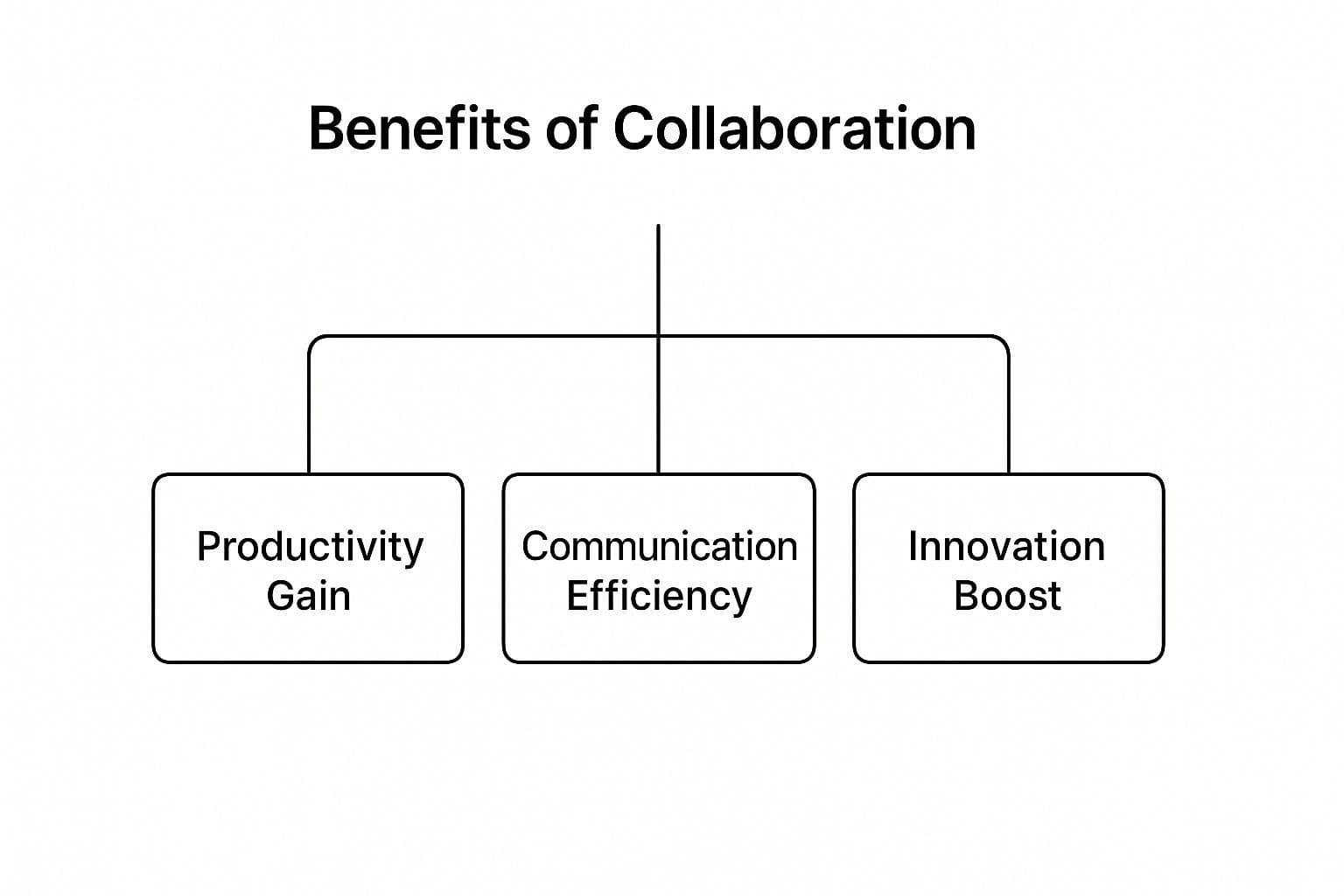Team collaboration is really just a fancy way of saying people are working together to hit a shared business goal. It’s about pooling everyone's unique skills, viewpoints, and energy in a smart, coordinated way to create something far better than anyone could have alone.
What Team Collaboration Really Means

Picture a band getting ready for a gig. The guitarist, drummer, and singer don't just practice their own parts in isolation. They have to get in the same room, sync their timing, and blend their sounds to create a cohesive song. One person playing solo is just making noise; together, they make music. That's pretty much what team collaboration looks like at work.
It’s about more than just being assigned to the same project or showing up for the same weekly meeting. Real collaboration hinges on active participation, honest communication, and a genuine respect for everyone on the team.
Beyond Simple Teamwork
We often toss around the words "teamwork" and "collaboration" like they're the same thing, but there's a small but crucial difference. Teamwork can be as straightforward as dividing up a to-do list. You write the report, I'll build the presentation slides.
Collaboration, on the other hand, is a much more tangled, interactive process. It’s about co-creating something from the ground up, where team members constantly build on each other's ideas, give feedback as things unfold, and puzzle through problems as a unit.
This is where the magic happens—that deeper level of interaction that sparks real breakthroughs. But it can only happen in an environment where people feel safe enough to toss out wild ideas, question the status quo, and bring their A-game. To get there, you need a few key ingredients:
- Shared Goals: Everyone on the team needs to know exactly what they're aiming for and be fully committed to getting there.
- Clear Communication: Information has to move freely and honestly. No silos, no secrets, no misunderstandings.
- Mutual Trust: People have to be able to count on each other's skills and good intentions, without anyone needing to micromanage.
When you get right down to it, team collaboration isn't just a soft skill; it's a strategic process. It’s the engine that powers innovation, makes work more efficient, and builds a stronger, more successful company. It’s what separates a random group of employees from a truly high-performing team.
Why Great Collaboration Is a Business Superpower

Let's be clear: great team collaboration isn’t just a "nice-to-have" part of your company culture. It's the engine that drives business growth. When your team clicks, the effect is felt everywhere—from the bottom line to the next big idea.
Think of it like an orchestra. When every musician is perfectly in sync, following the same conductor, they create something powerful. But if just one or two are playing their own tune, you get chaos instead of music. That chaos in business looks like missed deadlines, wasted money, and a team that's just plain frustrated.
Effective collaboration silences that noise and turns it back into a symphony, creating real, tangible benefits across the entire organization.
The Financial Impact of Cohesive Teams
There's a straight line connecting collaboration to profitability. It’s simple, really. When teams are engaged and aligned, they work smarter, solve problems faster, and make better decisions. This isn't just a hunch; the numbers back it up.
Highly engaged teams, for example, show a stunning 23% increase in profitability compared to their disconnected peers. They also stick around longer, which is huge when you consider how much it costs to hire and train new people. And with global teams becoming the norm—where about 30% of meetings span multiple time zones—having a solid collaborative framework is more critical than ever. You can dive deeper into how this works by checking out the full report on workplace collaboration statistics.
This performance boost comes from a few key places:
- Increased Productivity: Collaborative teams don’t duplicate work or get stuck in bottlenecks. Projects just flow better.
- Faster Innovation: When you bring different perspectives together, new ideas spark, get refined, and hit the market quicker.
- Better Decision-Making: A team that talks openly can look at a problem from all sides, leading to smarter, more solid solutions.
Building a Resilient and Agile Workforce
Beyond the immediate financial wins, a collaborative culture creates a company that can roll with the punches. When people feel connected and supported, they're more likely to stay, share what they know, and put in that extra effort when it counts.
This kind of adaptability is a massive competitive advantage. Teams that are used to working together are simply better at handling surprises and jumping on new opportunities.
Ultimately, figuring out what is team collaboration is realizing it's a strategic move. It’s about building an environment where the group's collective brainpower makes everyone better. By making teamwork the default, you’re not just improving a few projects—you’re setting your company up for success in the long run.
The Five Pillars of Winning Teams
So, how do you get a team to move beyond just working near each other and into a state of real, effective collaboration? It definitely doesn't happen by accident. I've found that the best teams are built on five core principles. Think of them as pillars holding up everything else.
It helps to picture a sports team. You could have a roster full of all-stars, but if they don't communicate, trust each other, or understand their individual roles, they're not winning any championships. The exact same thing happens in the office. Getting a handle on these five pillars is your first step toward building a team that doesn't just work—it wins.
Pillar 1: Clear Communication
This is the absolute lifeblood of collaboration. Clear communication is all about making sure information flows freely and openly among everyone on the team. It’s more than just talking; it’s about making sure everyone has the context they need to do their best work.
When communication breaks down, projects go off the rails. You see missed deadlines, duplicated work, and a whole lot of frustration. A culture of clear communication keeps everyone on the same page, from the big-picture goals right down to who's doing what. This means picking the right tools for the job and setting clear ground rules for how the team shares updates.
Pillar 2: Shared Goals
A team without a shared goal is really just a group of people working on separate to-do lists. To truly collaborate, everyone needs to be pulling in the same direction, united by a single, common purpose. This shared objective becomes the team’s North Star, guiding every decision and aligning everyone's efforts.
These goals have to be specific, measurable, and crystal clear to every single person. When the whole team is invested in the same outcome, individual agendas fade into the background. It creates a powerful sense of unity, making it natural for people to support each other—because a win for one is a win for all.
To get practical, check out how to collaborate in a project for real results and turn those goals into tangible achievements.

Pillar 3: Mutual Trust
Trust is the glue that holds a collaborative team together. It's the quiet confidence that your teammates are reliable, that they know what they're doing, and that they have good intentions. Without it, people start hoarding information, micromanaging, and playing it safe instead of taking smart risks.
Building trust means creating an environment of psychological safety, where people feel comfortable speaking up, admitting they made a mistake, or throwing out a wild new idea without fear of being shut down. It's about being dependable and, just as crucially, assuming others will be dependable too. When trust is high, teams just move faster and with a lot more confidence.
Pillar 4: Defined Roles
Collaboration can quickly spiral into chaos if nobody knows who's responsible for what. When you define roles clearly, every person on the team understands their specific duties, their level of authority, and exactly how their work plugs into the bigger picture. It's just like knowing your position on the field.
This clarity stops tasks from slipping through the cracks and prevents turf wars over who owns what. This isn’t about locking people into rigid boxes—roles can and should be flexible. The main thing is that everyone knows who the go-to person is for any given task, which keeps things moving and makes accountability simple.
Pillar 5: Constructive Feedback
A winning team is a growing team, and you simply can't have growth without feedback. Constructive feedback is the engine of continuous improvement. It’s how team members learn from missteps, sharpen their processes, and get better at what they do.
This has nothing to do with pointing fingers. It's about fostering a culture where feedback is given with respect and received with an open mind. Regular, thoughtful feedback helps people build their skills and ensures the team as a whole is always getting smarter. It’s what keeps the entire unit adapting and improving over time.
To wrap it up, these five pillars—communication, shared goals, trust, clear roles, and feedback—are the essential building blocks for any high-performing team. Below is a quick summary to help you keep these principles top of mind.
Pillars of Team Collaboration at a Glance
This table breaks down the five core principles, what they really mean in practice, and a few key actions you can take to bring them to life in your own team.
Focusing on strengthening these five areas will make a huge difference, turning a group of individuals into a truly collaborative force.
Common Roadblocks to Effective Teamwork

Even with the best intentions, teamwork can hit some frustrating snags. Knowing what these common roadblocks look like is the first step to dismantling them and building a team that really clicks. These issues often sneak in quietly, slowing everyone down and creating friction that can derail even the most talented groups.
Ever seen two colleagues accidentally do the exact same task? It’s a classic sign of collaboration gone wrong. It wastes time and energy, but more importantly, it points to a deeper issue in how the team works. Spotting these patterns early means you can fix them before they grow into real problems.
Information Silos and Communication Gaps
One of the biggest culprits I see is the information silo. This is what happens when different teams or even individual people work in their own little bubbles, holding onto knowledge instead of sharing it. Imagine a bunch of chefs in separate kitchens trying to cook one big meal. If they don't share recipes or ingredients, the result is a mess.
These silos create misunderstandings, duplicated work, and missed opportunities. When the marketing team has no idea what product is launching, or sales doesn't have the latest updates from customer support, the whole company feels it. You can get some great ideas on how to improve team communication with easy tips to start bridging these gaps.
Fear and a Lack of Psychological Safety
Another major barrier is a lack of psychological safety. It's a simple concept, really: it’s the shared feeling that it's okay to take risks. Can you ask a "dumb" question? Can you admit you made a mistake? Can you challenge an idea without getting shut down?
When that safety isn't there, people clam up. Good ideas die before they're ever spoken because no one wants to stick their neck out. Problems get swept under the rug because everyone is afraid to point out flaws. This kind of fear-based environment makes people focus on protecting themselves instead of contributing openly—the exact opposite of what great collaboration needs.
Leaders have to consciously build a culture of trust where being vulnerable is seen as a strength, not a weakness.
Unclear Roles and Competing Priorities
Finally, collaboration falls apart in the face of ambiguity. If people don't know exactly what their roles are, confusion is guaranteed. You get team members stepping on each other's toes, or worse, critical tasks get dropped because everyone assumed someone else was handling it.
In the same vein, competing priorities can tear a team in different directions. When leadership sends mixed messages about what’s most important, people will naturally drift toward their own goals instead of the team's. Real teamwork demands a single, unified focus where every single person knows their part and is running toward the same finish line.
Modern Tools and Strategies for Better Collaboration
Knowing what’s holding your team back is half the battle. Now, let’s talk about building the bridges to get over those hurdles. Great team collaboration isn’t something that just happens by accident; it's designed. It comes from mixing the right daily habits with the right technology to create an environment where working together feels seamless.
This isn't about chasing every shiny new app. It’s about being thoughtful and choosing strategies and tools that solve the real problems your team faces, whether you’re all in one office or scattered across different time zones.
Establish a Single Source of Truth
One of the most effective things you can do is create a single source of truth. Just think of it as your project’s central library. Instead of critical information being lost in a sea of emails, random chat threads, and personal hard drives, everything lives in one, easy-to-find place.
This could be a shared drive, a project management tool, or a team wiki. The moment everyone knows exactly where to look for the latest files, plans, and decisions, you cut out a ton of confusion and stop wasting time hunting for information.
Optimize Your Meeting Culture
Let's be honest, meetings can be a huge drain on time and energy. But they don't have to be. By rethinking how you approach them, you can transform them from frustrating obligations into focused, productive sessions.
A few simple ground rules can make a world of difference:
- Set Clear Agendas: Every meeting invite should spell out exactly what you're trying to achieve. No agenda, no meeting.
- Assign Action Items: Never end a meeting without clarifying who is doing what and when it’s due.
- Question Necessity: Before you book that slot, ask yourself: "Could this be handled with a quick message or an email?"
These small tweaks ensure that when you do get together, your time is spent moving work forward, not just filling the calendar.
Adopt the Right Collaboration Technology
Technology is your best friend when it comes to tearing down communication walls. The right tools can shrink distances, handle the boring stuff automatically, and keep the whole team on the same page. The trick is picking software that actually fits how your team works.
A solid digital toolkit for any modern team usually includes:
- Project Management Software: Tools like Trello or Asana give you a bird's-eye view of tasks, deadlines, and progress. Everyone can see who’s responsible for what at a glance.
- Communication Platforms: Instant messaging apps like Slack or Microsoft Teams cut down on email noise by creating dedicated channels for quick conversations.
- AI-Powered Assistants: Artificial intelligence is also stepping up in a big way. In fact, 75% of leaders who use AI tools say they’ve seen collaboration improve. You can learn more about how new tools are shaping workplace collaboration and helping teams get better results.
Finding the perfect mix of tools is especially important for remote and hybrid teams. For a more detailed walkthrough, take a look at our guide on choosing remote team collaboration software. The goal is simple: build a tech stack that makes teamwork easier, not more complicated.
Frequently Asked Questions About Team Collaboration
Even the best-laid plans hit a few bumps. When you start putting collaboration theory into practice, questions are bound to pop up. This section tackles some of the most common hurdles that leaders and teams run into. Think of it as a quick field guide for those tricky, real-world moments.
Let's get into it.
How Can You Measure Team Collaboration?
Measuring something as human as "collaboration" can feel like trying to bottle lightning, but it’s doable. The trick is to stop looking for one magic number and instead track the results of great teamwork.
Start by looking at your project metrics. Are you hitting deadlines more often? Is the quality of the work getting better? You can also use quick, anonymous surveys to get a pulse on team morale and psychological safety. Ask simple questions about whether people feel supported, heard, and respected.
Another huge clue is employee engagement. When collaboration is really clicking, people are naturally more bought-in and motivated.

